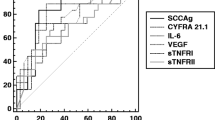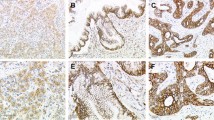Abstract
The incidence of stage Ib ~ IIa of cervical adenocarcinoma accounts about 60 to 70 % of all patients. This study aims to investigate the prognostic significance of protein estrogen receptor alpha (ERα) and transforming growth factor beta 1 (TGF-β1) level in different glandular epithelia of the cervix. In this study, immunohistochemistry was used to detect ERα and TGF-β1 in carcinomas and incisal margins of 66 cases with cervical adenocarcinoma, 20 cases with normal cervix, and 20 cases with chronic cervicitis. Uni- and multivariate analysis was applied to evaluate the prognostic significance of TGF-β1 and ERα in carcinomas. The results indicated that the positive expression of TGF-β1 in carcinomas was 71.21 %, significantly higher compared to that in the normal cervix (35 %) and chronic cervicitis (55 %) (χ 2 = 8.901, P = 0.012). Similarly, the positive expression of ERα in the carcinomas was 68.18 %, significantly higher compared to the normal cervix (35 %) and chronic cervicitis (50 %) (χ 2 = 7.693, P = 0.021). Both TGF-β1 and ERα in the carcinomas were associated with the vaginal recurrence, infection of HPV, depth of infiltration, and lymphatic metastasis (P < 0.05). The conjugation of TGF-β1 and ERα was an independent prognostic factor for cervical adenocarcinoma. Survival curve showed that the positive TGF-β1 and ERα indicated a short lifetime of patient with cervical adenocarcinoma. In conclusion, the expression of TGF-β1 and ERα protein in the carcinomas had a significant prognostic value in a patient of stage Ib ~ IIa in cervical adenocarcinoma.


Similar content being viewed by others
References
Alam MS, Ali A, Mehdi SJ, Alyasiri NS, Kazim Z, Batra S, et al. HPV typing and its relation with apoptosis in cervical carcinoma from India population. Tumor Biol. 2012;33(1):17–22.
Umezulike AC, Tabansi SN, Ewunonu HA, Nwana EJ. Epidemiological characteristics of carcinoma of the cervix in the Federal capital Territory of Nigeria. Niger J Clin Pract. 2007;10(1):143–6.
Ronco G, Anttila A. Cervical cancer screening in Europe—changes over the last 9 years. Eur J Cancer. 2009;45(15):2629–31.
Li W, Wu H, Song C. TGF-beta1-509C/T (or +869 T/C) polymorphism might be not associated with hepatocellular carcinoma risk. Tumor Biol. 2013;34(5):2675–81.
Li Q, Huang W, Zhou X. Expression of CD34, alpha-smooth muscle actin and transforming growth factor-beta1 in squamous intraepithelial lesions and squamous cell carcinoma of the cervix. J Int Med Res. 2009;37(2):446–54.
Stoica A, Saceda M, Fakhro A, Solomon HB, Fenster BD, Martin MB. The role of transforming growth factor-β in the regulation of estrogen receptor expression in the MCF-7 breast cancer cell line. Endocrinology. 2007;138(4):1498–505.
Cao ZY. Common gynecological cancer treatment guidelines. People’s Health Publishing House, 23-40.
Houvenaeghel G, Buttarelli M, Grégoire E. Locoregional recurrence of cervical and endometrial carcinoma: role of surgical resection. Bull Cancer. 2005;92(9):782–8.
Deng W, Tsao SW, Kwok YK, Wong E, Huang XR, Liu S, et al. Transforming growth factor beta1 promotes chromosomal instability in human papillomavirus 16 E6E7-infected cervical epithelial cells. Cancer Res. 2008;68(17):7200–9.
Hazelbag S, Kenter GG, Gorter A, Fleuren GJ. Prognostic relevance of TGF-beta1 and PAI-1 in cervical cancer. Int J Cancer. 2004;112(6):1020–8.
Burk RD, Terai M, Gravitt PE, Brinton LA, Kurman RJ, Barnes WA, et al. Distribution of human papillomavirus type 16 and 18 variants in squamous cell carcinomas and adenocarcinomas of the cervix. Cancer Res. 2003;63(6):7215–20.
Han CP, Lee MY, Tyan YS, Kok LF, Yao CC, Wang PH, et al. p16 INK4 and CEA can be mutually exchanged with confidence between both relevant three-marker panels (ER/Vim/CEA and ER/Vim/p16 INK4) in distinguishing primary endometrial adenocarcinomas from endocervical adenocarcinomas in a tissue microarray study. Virchows Arch. 2009;455(4):353–61.
Geiger TR, Peeper DS. Metastasis mechanisms. Biochim Biophys Acta. 2009;33(6):765–9.
Kuroishi S, Suda T, Fujisawa T, Ide K, Inui N, Nakamura Y, et al. Epithelial-mesenchymal transition induced by transforming growth factor-beta1 in mouse tracheal epithelial cells. Respirology. 2009;14(6):828–37.
Yi J, Hur K, Lee E. TGF beta1-mediated epithelial to mesenchymal transition is accompanied by invasion in the SiHa cell line. Eur J Cell Biol. 2002;81(6):457–68.
Macdonald OK, Chen J, Dodson M, Lee CM, Gaffney DK. Prognostic significance of histology and positive lymph node involvement following radical hysterectomy in carcinoma of the cervix. Am J Clin Oncol. 2009;32(4):411–6.
Hazelbag S, Kenter GG, Gorter A, et al. Prognostic relevance of TGF-beta1 and PAI-1 in cervical cancer. Int J Cancer. 2004;112(6):1020–8.
Conflicts of interest
None
Author information
Authors and Affiliations
Corresponding author
Rights and permissions
About this article
Cite this article
Fan, DM., Tian, XY., Wang, RF. et al. The prognosis significance of TGF-β1 and ER protein in cervical adenocarcinoma patients with stage Ib ~ IIa. Tumor Biol. 35, 11237–11242 (2014). https://doi.org/10.1007/s13277-014-2110-y
Received:
Accepted:
Published:
Issue Date:
DOI: https://doi.org/10.1007/s13277-014-2110-y




